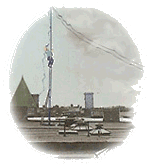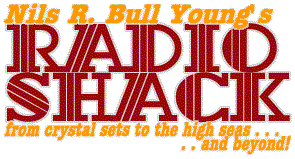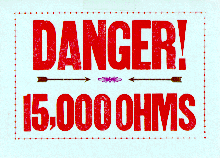
I forgot to mention in the last page how the three of us went on a three-week vacation to the western states and blew up two radios in the process. But that's what happened.
See, just before we took off, I decided to clean up a mod that I'd made in the SG2020 so I could run electret mics in it. I wanted to replace a 78L05 voltage regulator & associated wiring so that it was a bit cleaner. So I opened up the radio and hosed it up to the power.
Then I shorted out the B+ line & smoked the MOSFET that turned the radio off and on.
I figured shortly after that to fix things by hard-wiring the power line on. That worked great until somewhere in the middle of Estes Park, Colorado, the radio did one of the faults-on-power-up tricks for which it has become famous on the web. All I got was a display of 66.66666 & no memory channels. So for the rest of the trip the HF set up was shot.
And then . . .
Right after Cindy heard from her mother on the cell phone that the upstairs toilet had sprung a leak and drained water into the downstairs kitchen ceiling (which we'd just remodeled), we were driving through some weather in Texas. About 15 miles ahead we could see a storm cloud and rain coming down from it. There was no other bad weather around us for miles.
As we drove along, I became aware of a ticking/popping noise coming from the 20-year-old Pace Communicator II 2m FM radio. I was picking up static on the antenna at such a level that it was arcing across the antenna connector of the 2m radio. By the time I got the antenna disconnected (at >70mph), the 2m radio was toast. The display was half there & I got almost nada output. And it wouldn't do repeater splits.
So you can now get some idea of how my radio luck was working out
I had given up on the amplifier and now had only the SG2020, which I would have to send back to the factory for repair. And I now had no 2m radio. Which wasn't a big deal 'cause I didn't use 2m for much other than on the road for long-distance trips. I mean, I didn't even take it to the beach the year before.
When we got home, I sent the '2020 in for repairs & got it back. Then I put all the stuff that I'd collected for QRP ops in one big pile & put it up for sale on the web. A couple months later it was all gone. And I'd worked enough overtime to replace it all with the Icom IC-718. And at the subsequent Hamvention I picked up an Icom T2H 2m handie-talkie.
I was back in QRO business and I had a good 2m radio that could be used with a car-power adaptor & speaker mic as a 5W mobile rig. Then I discovered that the '718 could be turned down to .5W, which put me back in the QRPp party again . . . if I wanted to. Thenk, a few months later, I got a big bunch of overtime in, sold some more stuff & had enough to spring for an Icom IC-706Mk2G.
So by this time I had two HF radios, a radio that did HF & 6m
and 2m & 70cm. I could get on the road again . . . in any number of styles . . .
The Best of Both Worlds
Updated 25 July 2004
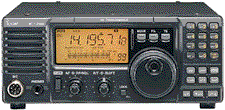
One of the joys of having the IC-718 turned up one evening when I was listening around between 150kHz and 400kHz, that part of the world where most folks never listen . . . unless they're lost in a Piper Cub at 1500 feet. The VLF part of the spectrum.
It was somewhere in winter & late at night. I could hear all the local non-directional beacons (NDBs): Xenia, Covington, Dayton, other local airports. And then I came across the NDB from Newfoundland. I thought that was pretty sweet.
Then I picked out the call of an NDB in San Juan, Puerto Rico.
I think it was then that I became totally accepting of the change that I'd made going from QRP/kit-built to QRO/factory-built. Here I was, listening to DX NDBs on a piece of aluminum out in the yard running through no tuner or any other coupler, on a radio that the magazines had called "entrance level."
Hell, I'd done "entrance level" for so long that I didn't know any better! "Entrance Level" my ass! I had a radio with two VFOs, a CW filter, AM receive, general coverage receive & total HF & MF ham band transmit
and I could hear NDBs in far-flung places on it! If this was "entrance level," then I must have led a very sheltered "entrance level" life in ham radio. I think that the IC-718 could easily put a USN-vintage R390 receiver to the test, all things considered.
At which point I started thinking about getting back into VHF.
After all, hadn't I blown up a 2m mobile rig out in the Texas plains somewhere? At least that's the way I figured it. And besides, the '718 is a bit too big to fit in the "vacation radio travel case" thingie
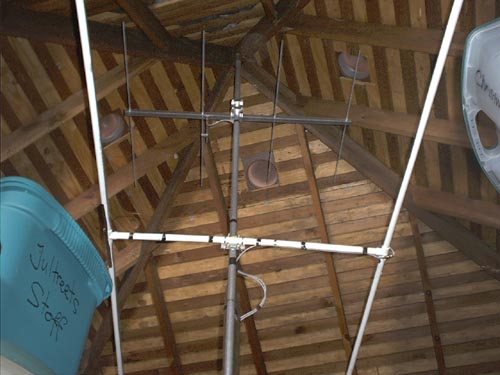
that I'd used to haul the K2 and the SG2020 around in. I mean I spent a lot of time thinking about this, trying not to look to bipolar about it. Sure, I had a nice HF radio, but for a bit more overtime, and if I sold some stuff, I could get . . . Well, you get the picture.
It took me a bit longer to collect the cash & maintain the level of subterfuge that would allow me to send off money in a big chunk to Gigaparts.com for the IC-706Mk2G. The name of the radio being as long as it was, it only made sense to think about it a while. To waffle about it for a while. To distract myself with other foolishness a while before finally making the on-line purchase.
Which is another thing!
I was getting too accomplished at this on-line radio buying anyway. I'd bought the IC-718 off TexasTowers.com 'cause they had a sale special on it & it came with some extra doodads. The DSP filter board, if memory serves. The IC-706Mk2, that one came with the DSP installed. The extras were the mobile mount &c. And since I'd bought the 500Hz filter for the '718, I put the 300Hz filter in the '706 when it arrived. And arrive it did.
See, if you buy on-line, you can track your stuff as it makes its way from the warehouse or

whatever to your front porch. And the day the '706 arrived, I went home for lunch, picked it up and drug it's pretty little face back to work. Then I amazed my co-workers by not blowing it up when I got it out of the box.
Later on, when I had it home, I checked it out. On all bands. On HF it was a firm keeper. I could hear anything on the '706 that I could hear on the 718, at least between 3.5 & 30 MHz. On MF (160m) it was useful but not quite as hot as the '718. And it was a total toad on VLF. But then I hadn't really bought it for the VLF parts, seein' as how that's not a portable planet anyway. I'd gotten the IC-706Mk2G (I'm getting tired of all those letters, which is another story) because it had 6m, 2m and 70cm on it. And on those 'ns it cooked. Seriously.
I loaded the memories up with all my favorite repeater & simplex frequencies. I built a 450MHz verticle out of some wire, stapled it to the rafters in the attic & listened around. Most of the local repeaters were no sweat. I figured that was good.
Then I cobbled together a wire verticle for 2m and tried that. Once again, it was cool. And I could copy the weather channels, the local hippie FM radio stations on WFM and airplanes & fire & rescue services. I could listen to the county sherriff deputies pullin' over drunk rednecks and HIV-positive junkies who shot themselves in the leg while shootin' up at the local gravel pit.
And I could hear all my neighbors' wireless baby monitors and 49MHz cordless phones. Now that, that was
very interesting!
Later on I added an
Arrow Antennas 2m five-element beam & one of their 2m/70cm J-pole antennas. Having a real antenna helps. I could copy the Cincinnati 2m repeaters and a few of the distant 70cm machines too. But the real kick was 6m, for which I'd constructed a nominally functional
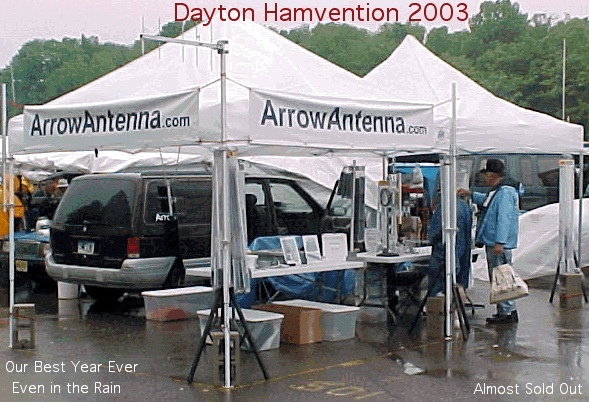
two-element beam out of PVC pipe and aluminum duct tape. I put all those antennas in the attic, which put them over my head at 22ft elevation off the ground. On a good day with no
L's in the week.
And then . . .
And then, at the in the rain, I bought a five-element 6m beam from Arrow Antennas. It arrived about a week later. I managed to put it together in the attic & pulled down the duct-tape-and-PVC-pipe monstrosity. Then I went downstairs to listen.
In one of those rare moments of good luck for which I've become famous, there was a 6m opening. I talked to stations in Florida, Illinois & along the southeast coast of the USA. Obviously the PVC thingie had been more of a dummy load than an antenna. I was elated.
I was so elated, in fact, that I reaffirmed my decision of some months earlier never to build anything with more than 20 parts in it. Which, as you can expect me to say often enough by now,
leads to the next page.
